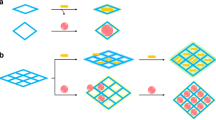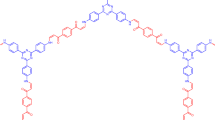Abstract
The development of a new methodology for visualizing and detecting gases is imperative for various applications. Here, we report a novel strategy in which gas molecules are detected by signals from a reporter guest that can read out a host structural transformation. A composite between a flexible porous coordination polymer and fluorescent reporter distyrylbenzene (DSB) selectively adsorbed CO2 over other atmospheric gases. This adsorption induced a host transformation, which was accompanied by conformational variations of the included DSB. This read-out process resulted in a critical change in DSB fluorescence at a specific threshold pressure. The composite shows different fluorescence responses to CO2 and acetylene, compounds that have similar physicochemical properties. Our system showed, for the first time, that fluorescent molecules can detect gases without any chemical interaction or energy transfer. The host–guest coupled transformations play a pivotal role in converting the gas adsorption events into detectable output signals.
This is a preview of subscription content, access via your institution
Access options
Subscribe to this journal
Receive 12 print issues and online access
$259.00 per year
only $21.58 per issue
Buy this article
- Purchase on Springer Link
- Instant access to full article PDF
Prices may be subject to local taxes which are calculated during checkout




Similar content being viewed by others
References
Wolfbeis, O. S. Fiber-optic chemical sensors and biosensors. Anal. Chem. 74, 2663–2677 (2002).
Lee, Y-E. K. & Kopelman, R. Optical nanoparticle sensors for quantitative intracellular imaging. Wiley Interdiscip. Rev. Nanomed. Nanobiotechnol. 1, 98–110 (2009).
Dansby-Sparks, R. N. et al. Fluorescent-dye-doped sol–gel sensor for highly sensitive carbon dioxide gas detection below atmospheric concentrations. Anal. Chem. 82, 593–600 (2010).
Demas, J. N., DeGraff, B. A. & Coleman, P. B. Oxygen sensors based on luminescence quenching. Anal. Chem. 1, 793–800 (1999).
Baratto, C. et al. Luminescence response of ZnO nanowires to gas adsorption. Sens. Actuat. B 140, 461–466 (2009).
Esser, B. & Swager, T. M. Detection of ethylene gas by fluorescence turn-on of a conjugated polymer. Angew. Chem. Int. Ed. 49, 8872–8875 (2010).
de Vargas-Sansalvador, I. M. P. et al. Phosphorescent sensing of carbon dioxide based on secondary inner-filter quenching. Anal. Chim. Acta 655, 66–74 (2009).
Liu, Y. et al. Fluorescent chemosensor for detection and quantitation of carbon dioxide gas. J. Am. Chem. Soc. 132, 13951–13953 (2010).
Gerasimchuk, N., Esaulenko, A. N., Dalley, K. N. & Moore, C. 2-Cyano-2-isonitrosoacetamide and its Ag(I) complexes. Silver(I) cyanoximateas a non-electric gas sensor. Dalton Trans. 39, 749–764 (2010).
Yaghi, O. M. et al. Reticular synthesis and the design of new materials. Nature 423, 705–714 (2003).
Kitagawa, S., Kitaura, R. & Noro, S-i. Functional porous coordination polymers. Angew. Chem. Int. Ed. 43, 2334–2375 (2004).
Bradshaw, D., Claridge, J. B., Cussen, E. J., Prior, T. J. & Rosseinsky, M. J. Design, chirality, and flexibility in nanoporous molecule-based materials. Acc. Chem. Res. 38, 273–282 (2005).
Férey, G. Hybrid porous solids: Past, present, future. Chem. Soc. Rev. 37, 191–214 (2008).
Murray, L. J., Dincă, M. & Long, J. R. Hydrogen storage in metal-organic frameworks. Chem. Soc. Rev. 38, 1294–1314 (2009).
Xiao, B. et al. Chemically blockable transformation and ultraselective low-pressure gas adsorption in a non-porous metal organic framework. Nature Chem. 1, 289–294 (2009).
Chen, B. L. et al. A luminescent metal-organic framework with Lewis basic pyridyl sites for the sensing of metal ions. Angew. Chem. Int. Ed. 48, 500–503 (2009).
Zacher, D., Shekhah, O., Wöll, C. & Fischer, R. A. Thin films of metal-organic frameworks. Chem. Soc. Rev. 38, 1418–1429 (2009).
McKinlay, A. C. et al. BioMOFs: Metal-organic frameworks for biological and medical applications. Angew. Chem. Int. Ed. 49, 6260–6266 (2010).
Vaidhyanathan, R. et al. Direct observation and quantification of CO2 binding within an amine-functionalized nanoporous solid. Science 330, 650–653 (2010).
Xie, Z., Ma, L., deKrafft, K. E., Jin, A. & Lin, W. Porous phosphorescent coordination polymers for oxygen sensing. J. Am. Chem. Soc. 132, 922–923 (2010).
Rabone, J. et al. An adaptable peptide-based porous material. Science 329, 1053–1057 (2010).
Sato, H., Matsuda, R., Sugimoto, K., Takata, M. & Kitagawa, S. Photoactivation of a nanoporous crystal for on-demand guest trapping and conversion. Nature Mater. 9, 661–666 (2010).
Meek, S. T., Greathouse, J. A. & Allendorf, M. D. Metal-organic frameworks: A rapidly growing class of versatile nanoporous materials. Adv. Mater. 23, 249–267 (2011).
Choi, H. J., Dincă, M. & Long, J. R. Broadly hysteretic H2 adsorption in the microporous metal-organic framework Co(1,4-benzenedipyrazolate). J. Am. Chem. Soc. 130, 7848–7850 (2008).
Férey, G. & Serre, C. Large breathing effects in three-dimensional porous hybrid matter: Facts, analyses, rules and consequences. Chem. Soc. Rev. 38, 1380–1399 (2009).
Li, J-R., Kuppler, R. J. & Zhou, H-C. Selective gas adsorption and separation in metal-organic frameworks. Chem. Soc. Rev. 38, 1477–1504 (2009).
Muraoka, T., Kinbara, K. & Aida, T. Mechanical twisting of a guest by a photoresponsive host. Nature 440, 512–515 (2006).
Llewellyn, P. L., Bourrelly, S., Serre, C., Filinchuk, Y. & Férey, G. How hydration drastically improves adsorption selectivity for CO2 over CH4 in the flexible chromium terephthalate MIL-53. Angew. Chem. Int. Ed. 45, 7751–7754 (2006).
Oelkrug, D. et al. Towards highly luminescent phenylene vinylene films. Synth. Met. 83, 231–237 (1996).
Oelkrug, D. et al. Tuning of fluorescence in films and nanoparticles of oligophenylenevinylenes. J. Phys. Chem. B 102, 1902–1907 (1998).
Gierschner, J. et al. Solid-state optical properties of linear polyconjugated molecules: π-stack contra herringbone. J. Chem. Phys. 123, 144914 (2005).
Dybtsev, D. N., Chun, H. & Kim, K. Rigid and flexible: A highly porous metal-organic framework with unusual guest-dependent dynamic behavior. Angew. Chem. Int. Ed. 43, 5033–5036 (2004).
Müller, M., Devaux, A., Yang, C-H., De Cola, L. & Fischer, R. A. Highly emissive metal-organic framework composites by host-guest chemistry. Photochem. Photobiol. Sci. 9, 846–853 (2010).
Furuya, K., Kawato, K., Yokoyama, H., Sakamoto, A. & Tasumi, M. Molecular distortion of trans-stilbene and the Raman intensity of the in-phase CH out-of-plane wag of the central CH=CH group. J. Phys. Chem. A 107, 8251–8258 (2003).
Kasha, M., Rawls, H. R. & El-Bayoumi, M. A. The exciton model in molecular spectroscopy. Pure Appl. Chem. 11, 371–392 (1965).
An, B-K., Kwon, S-K., Jung, S-D. & Park, S. Y. Enhanced emission and its switching in fluorescent organic nanoparticles. J. Am. Chem. Soc. 124, 14410–14415 (2002).
Choi, H-S. & Suh, M. P. Highly selective CO2 capture in flexible 3D coordination polymer networks. Angew. Chem. Int. Ed. 48, 6865–6869 (2009).
Kanoh, H. et al. Elastic layer-structured metal organic frameworks (ELMS). J. Colloid Interface Sci. 334, 1–7 (2009).
Nakagawa, K. et al. Enhanced selectivity of CO2 from a ternary gas mixture in an interdigitated porous framework. Chem. Commun. 46, 4258–4260 (2010).
Swiatkowski, G., Menzel, R. & Rapp, W. Hindrance of the rotational relaxation in the excited singlet-state of biphenyl and para-terphenyl in cooled solutions by methyl substituents. J. Lumin. 37, 183–189 (1987).
Matsuda, R. et al. Highly controlled acetylene accommodation in a metal-organic microporous material. Nature 436, 238–241 (2005).
Samsonenko, D. G. et al. Microporous magnesium and manganese formates for acetylene storage and separation. Chem. Asian J. 2, 484–488 (2007).
Zhang, J-P. & Kitagawa, S. Supramolecular isomerism, framework flexibility, unsaturated metal center, and porous property of Ag(I)/Cu(I) 3,3′,5,5′-tetrametyl-4,4′-bipyrazolate. J. Am. Chem. Soc. 130, 907–917 (2008).
Fischer, M., Hoffmann, F. & Fröba, M. New microporous materials for acetylene storage and C2H2/CO2 separation: Insights from molecular simulations. ChemPhysChem 11, 2220–2229 (2010).
Yanai, N. et al. End-functionalization of a vinylidene fluoride oligomer in coordination nanochannels. J. Mater. Chem. 21, 8021–8025 (2011).
Löwe, C. & Weder, C. Oligo(p-phenylene vinylene) excimers as molecular probes: Deformation-induced color changes in photoluminescent polymer blends. Adv. Mater. 14, 1625–1629 (2002).
Mutai, T., Satou, H. & Araki, K. Reproducible on–off switching of solid-state luminescence by controlling molecular packing through heat-mode interconversion. Nature Mater. 4, 685–687 (2005).
Hong, Y. N., Lam, J. W. Y. & Tang, B. Z. Aggregation-induced emission: Phenomenon, mechanism and applications. Chem. Commun. 4332–4353 (2009).
van Hutten, P. F., Krasnikov, V. V., Brouwer, H-J. & Hadziioannou, G. Excimer luminescence from single crystals and films of a cyano-substituted phenylene-vinylene model compound. Chem. Phys. 241, 139–154 (1999).
Campbell, T. W. & Mcdonald, R. N. Synthesis of hydrocarbon derivatives by the Wittig synthesis. I. Distyrylbenzenes. J. Org. Chem. 24, 1246–1251 (1959).
Acknowledgements
This work was supported by the Murata Science Foundation, ERATO-JST, a Grant-in-Aid for Young Scientists (A), and a Grant-in-Aid for Scientific Research on Innovative Area ‘Emergence in Chemistry’ from MEXT. The synchrotron radiation experiments were carried out at BL02B2 in SPring-8 with the approval of the Japan Synchrotron Radiation Research Institute (JASRI) (Proposal no. 2009B1320).
Author information
Authors and Affiliations
Contributions
N.Y., K.K., and T.U. designed and carried out the experiments. Y.H. performed the density functional calculations. H.S. and R.M. performed in-situ infrared and Raman measurements. Y.K. and M.T. assisted with the in situ synchrotron XRPD measurements and carried out the Le Bail fitting analysis of the XRPD data. M.M. contributed 2H NMR measurements. N.Y., K.K., T.U., and S.K. wrote the manuscript.
Corresponding authors
Ethics declarations
Competing interests
The authors declare no competing financial interests.
Supplementary information
Supplementary Information
Supplementary Information (PDF 2384 kb)
Rights and permissions
About this article
Cite this article
Yanai, N., Kitayama, K., Hijikata, Y. et al. Gas detection by structural variations of fluorescent guest molecules in a flexible porous coordination polymer. Nature Mater 10, 787–793 (2011). https://doi.org/10.1038/nmat3104
Received:
Accepted:
Published:
Issue Date:
DOI: https://doi.org/10.1038/nmat3104
This article is cited by
-
Controlled assemblies of conjugated polymers in metal−organic frameworks
Polymer Journal (2022)
-
Guest-adaptive molecular sensing in a dynamic 3D covalent organic framework
Nature Communications (2022)
-
Selective capture of carbon dioxide from hydrocarbons using a metal-organic framework
Nature Communications (2021)
-
A metal–organic framework that exhibits CO2-induced transitions between paramagnetism and ferrimagnetism
Nature Chemistry (2021)
-
Frustrated flexibility in metal-organic frameworks
Nature Communications (2021)



